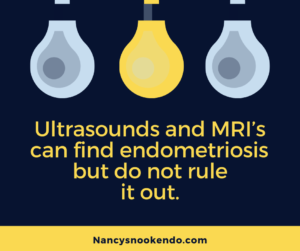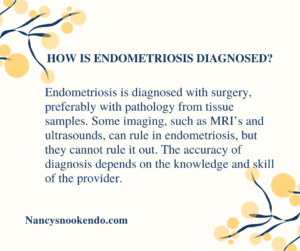How is endometriosis diagnosed?
Although your provider may suspect endometriosis, surgery is required to confirm diagnosis. The gold standard for diagnosis is a biopsy (cutting out the suspicious tissue during surgery) and confirmation by pathologist (a specialized physician the removed tissue under microscope).
It is important that a surgeon experienced in identifying endometriosis perform the surgery to reduce the possibility of missing the diagnosis. Other tests, such as ultrasounds and magnetic resonance imaging, can help identify other problems or help the surgeon to prepare for surgery, but they are not used to diagnose endometriosis. “It is quite difficult to identify superficial diseases, peritoneal lesions, or early/mild deep endometriosis by imaging modalities (17,18), indicating that a negative diagnosis cannot rule out endometriosis” (Imanaka et al., 2020, para. 8).
It is also important that your provider is able to evaluate you for other conditions that may be contributing to your symptoms. Often individuals with endometriosis have other conditions that also need to be addressed. (see “Related Conditions”) These include but are not limited to:
- Pelvic floor muscle pain
- Adenomyosis
- Interstitial cystitis/bladder pain syndrome
Links:
- Fischer, J., Giudice, L. C., Milad, M., Mosbrucker, C., & Sinervo, K. R. (2013). Diagnosis & management of endometriosis: pathophysiology to practice. APGO Educational Series on Women’s Health Issues. Retrieved from https://www.ed.ac.uk/files/atoms/files/diagnosis_and_management_of_endometriosis_booklet.pdf

Reference
Imanaka, S., Maruyama, S., Kimura, M., Nagayasu, M., & Kobayashi, H. (2020). Towards an understanding of the molecular mechanisms of endometriosis-associated symptoms. World Academy of Sciences Journal, 2(4), 1-1. Retrieved from https://www.spandidos-publications.com/10.3892/wasj.2020.53
Course Features
- Lectures 6
- Quizzes 0
- Duration 50 hours
- Skill level All levels
- Language English
- Students 1
- Assessments Yes







